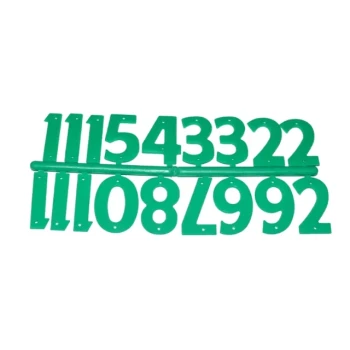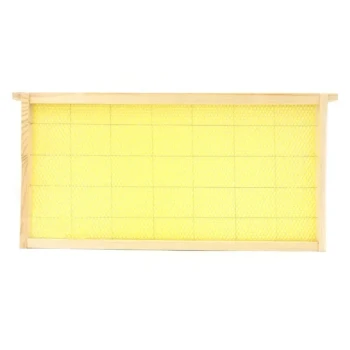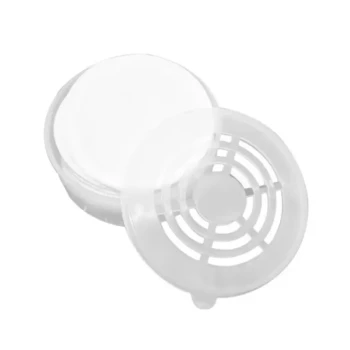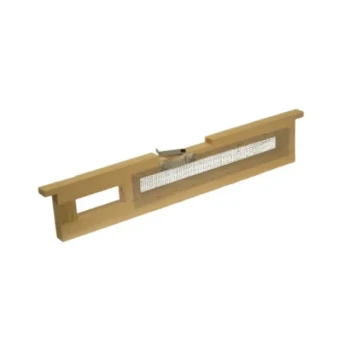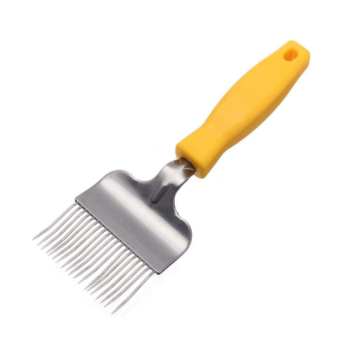Yes, a beekeeper absolutely can be stung through a bee suit. While a quality suit provides significant protection and makes beekeeping much safer, it is not an infallible shield. Stings that occur through a suit are relatively rare and are most often the result of an exposed gap in the gear or the fabric being pressed tightly against the skin.
Your bee suit is a critical tool that drastically reduces the likelihood of stings, but true safety comes from combining the gear with calm, deliberate beekeeping practices. The suit is your first line of defense; your technique is the second.
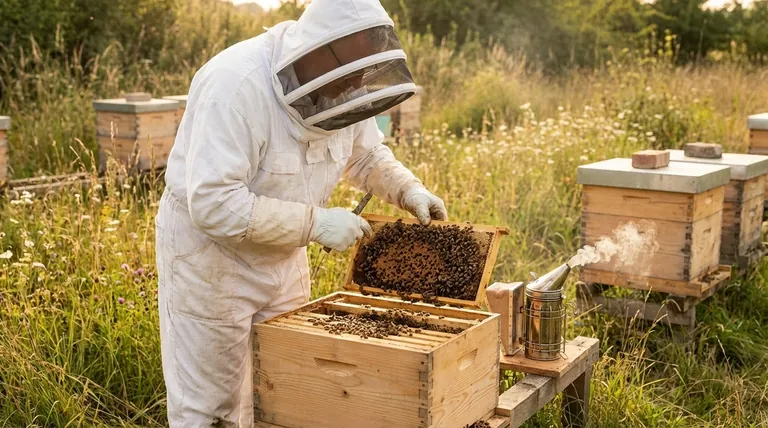
Why a Bee Suit Isn't Completely Sting-Proof
A bee suit is designed to be a physical barrier. However, a determined bee can occasionally breach this defense, typically through two primary mechanisms.
The Mechanics of a Sting
A bee's stinger is a sharp, barbed instrument. If the fabric of your bee suit is pulled taut against your skin—for example, when you bend your knee or elbow—the stinger may be long enough to penetrate the material and reach you.
This is why wearing a layer of clothing underneath your suit is a common and effective practice. The extra layer adds thickness and helps ensure a gap of air remains between the suit and your skin.
Finding the Gaps
The most common cause of stings while wearing a suit is a failure at a connection point. Bees are adept at finding small openings to crawl into.
Vulnerable areas often include the zippers, the seal between the veil and the suit's collar, and the elastic cuffs at your wrists and ankles. A single bee that gets inside the suit can become agitated and deliver multiple stings.
The Critical Role of Beekeeper Behavior
The most effective tool for preventing stings is not the suit itself, but the person wearing it. Your actions have a direct impact on the temperament of the hive.
Calm and Deliberate Movements
Bees often react defensively to sudden, jarring movements, which they can perceive as a threat from a predator. Handling frames gently and moving slowly around the hive minimizes their alarm.
Staying calm is crucial. If a bee lands on your suit or veil, the correct response is to remain still and allow it to move on, rather than swatting at it.
Using a Smoker Correctly
A smoker is an indispensable beekeeping tool. The smoke has two effects: it triggers a feeding response in the bees as they prepare to potentially abandon the hive, making them more docile.
More importantly, the smoke masks the alarm pheromone that guard bees release when they feel threatened. This pheromone would otherwise signal the rest of the colony to attack, so using a smoker prevents a defensive chain reaction.
Understanding Bee Temperament
Not all honeybees are the same. Hives with gentle, commercially reared queens are typically much less defensive than feral colonies. The genetics of your bees play a significant role in how pleasant your hive inspections will be.
Common Pitfalls and Human Error
Most stings that occur while wearing a suit can be traced back to a preventable mistake. Being mindful of these common errors is key to staying safe.
Improperly Sealed Entry Points
Before approaching a hive, always double-check that every zipper is fully closed. Ensure your gloves securely overlap your sleeve cuffs and that your boots or ankle straps leave no gap at your pants cuffs. The connection of your veil is the most critical checkpoint.
Worn-Out or Damaged Gear
A bee suit with holes, tears, or failing elastic is an invitation for trouble. Regularly inspect your gear for signs of wear and repair or replace it as needed.
Rushing the Process
Beekeeping requires patience. Rushing through a hive inspection leads to clumsy movements, dropped frames, and agitated bees. This dramatically increases the likelihood of stings for both you and the bees.
How to Maximize Your Protection
Your approach to safety should match your goals and comfort level. Consider these strategies to make your beekeeping experience as safe and enjoyable as possible.
- If your primary focus is minimizing all risk: Wear a thick layer of clothing under a high-quality, ventilated suit, and perform a meticulous gear check for any gaps before every hive inspection.
- If your primary focus is building confidence as a new beekeeper: Choose a bee colony known for its gentle genetics, use your smoker consistently, and prioritize slow, deliberate movements above all else.
Ultimately, a bee suit is an essential piece of safety equipment, but your knowledge and calm demeanor are your most powerful forms of protection.
Summary Table:
| Common Cause of Sting | How to Prevent It |
|---|---|
| Fabric pressed against skin | Wear a layer of clothing underneath the suit |
| Gaps at zippers, cuffs, or veil | Perform a meticulous gear check before every inspection |
| Agitated bees due to rushed movements | Use slow, calm, and deliberate techniques |
| Worn-out or damaged suit material | Regularly inspect and maintain your gear |
Ready to upgrade your apiary's safety and efficiency?
HONESTBEE supplies commercial apiaries and beekeeping equipment distributors with durable, high-quality beekeeping suits and essential gear through our wholesale-focused operations. Our equipment is designed to provide maximum protection, allowing you to work with confidence and focus on hive health.
Contact HONESTBEE today to discuss your wholesale needs and discover how our reliable supplies can support your beekeeping success.
Visual Guide
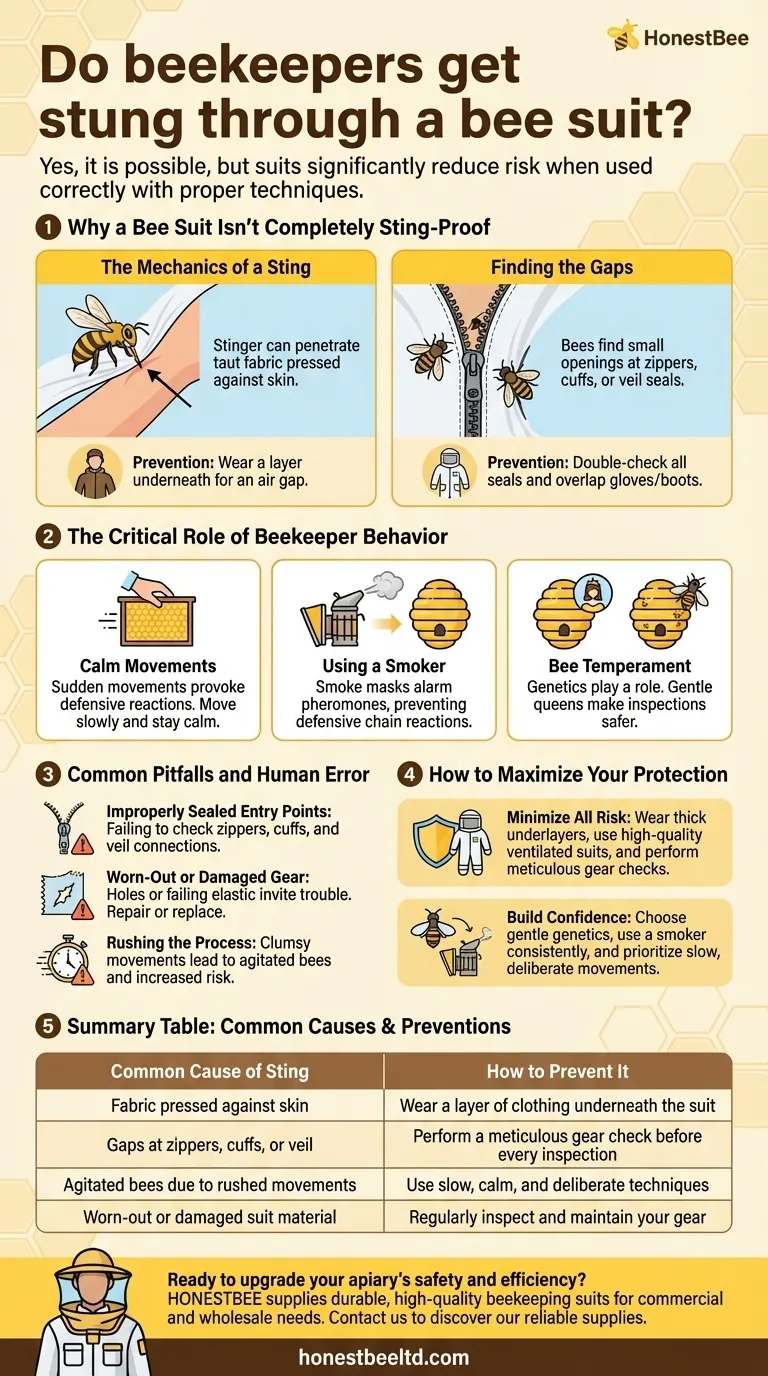
Related Products
- Wholesales Dadant Size Wooden Bee Hives for Beekeeping
- Yellow Plastic Bucket Pail Perch for Beekeeping
- Professional Insulated Winter Hive Wrap for Beekeeping
- Long Langstroth Style Horizontal Top Bar Hive for Wholesale
- Automatic Honey Flow Beehive 4 Frame Mini Hive for Beekeeping
People Also Ask
- What are the essential pieces of equipment for most beekeepers? Get Started with the Right Gear
- What should you do if you find an ant nest near your beehive? Essential Strategies for Hive Protection
- What is beekeeping equipment? Essential Tools for Commercial Apiaries & Distributors
- What is the best place to keep bees? Find the Perfect Apiary Site for Your Hives
- What are the advantages of wooden bee hives? Superior Bee Health & Beekeeper Flexibility







